Creamy Make-Ahead Mashed Potatoes
This post may contain affiliate links. Read my full disclosure policy.
Perfect for the busy holidays, these ultra-creamy make-ahead mashed potatoes can be prepared two days ahead of time and reheated in the microwave.
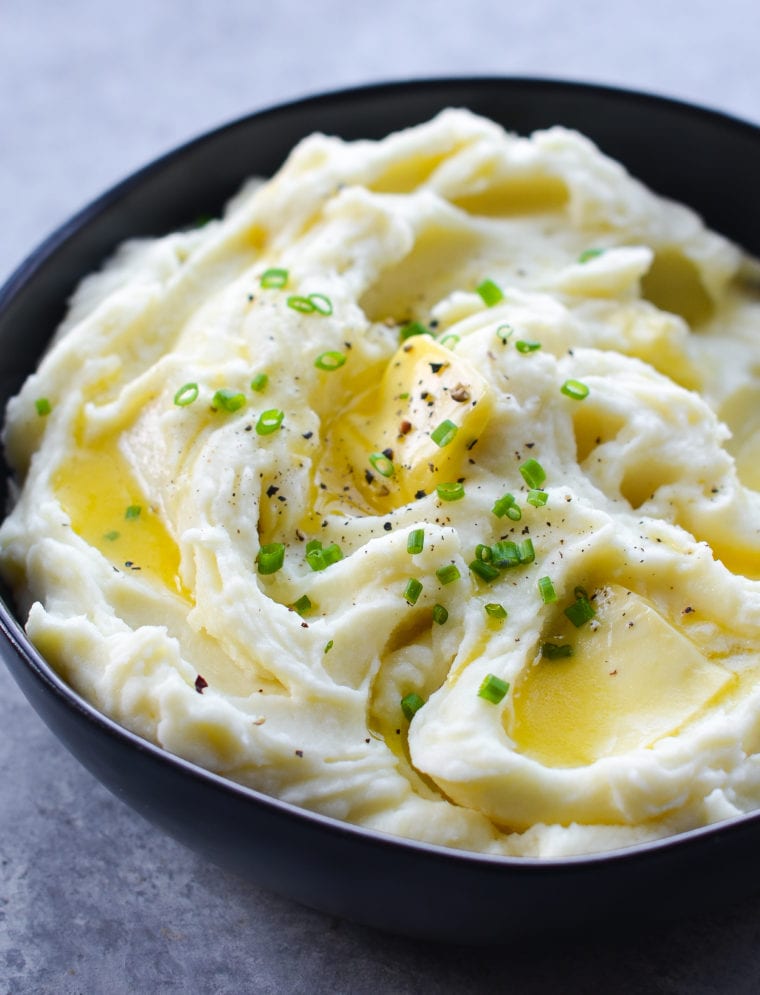
As much as my family loves buttery, gravy-drenched mashed potatoes on Thanksgiving, I’m always hesitant to make them because they’re typically a last-minute dish. Traditional mashed potatoes don’t hold up well when made ahead—they often turn dry, grainy, or even gluey, which is a real letdown for such a special occasion. And the idea of mashing potatoes at the eleventh hour, while juggling a dozen other dishes in a kitchen buzzing with guests of all ages, is downright nerve-wracking!
That’s why I was thrilled to discover a method for make-ahead mashed potatoes from Cooks Illustrated that works really well. These mashed potatoes stay ultra-creamy and can be made up to two days ahead of time. Best of all, they reheat perfectly in the microwave—a lifesaver when oven and burner space is at a premium during the holidays.
“I’ve always dreaded making mashed potatoes on the day of Thanksgiving. Too much work and mess, and they never seem to come out the way I want them to. These make-ahead mashed potatoes were the perfect solution! And they were so creamy and delicious!! They got rave reviews from my family and definitely earned a permanent spot on my Thanksgiving menu!”
What You’ll Need For Make-Ahead Mashed Potatoes
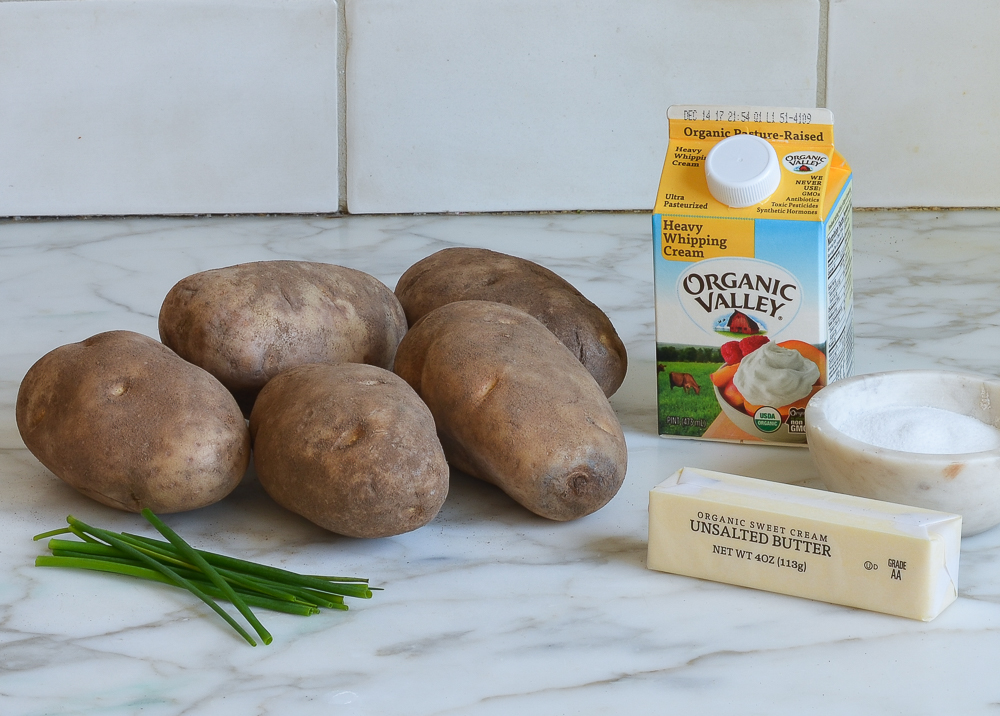
Interestingly, the recipe calls for baking the potatoes instead of boiling them. In all my years of cooking, I have never seen a mashed potato recipe that starts with baked potatoes. But it makes sense: water is the enemy of perfectly mashed potatoes. If the potatoes are too wet, they become dense and heavy. (That’s why most recipes instruct you to “dry” the boiled potatoes on the stovetop before adding the butter and liquid.) In many ways, the recipe is similar to twice-baked potatoes, which can also be made mostly ahead.
Baking the potatoes does take longer but it’s a tradeoff: you don’t have to peel or dry the potatoes and it’s completely hands-off. And since the potatoes cook directly on the oven rack, you won’t even dirty a pan!
Step-by-Step Instructions
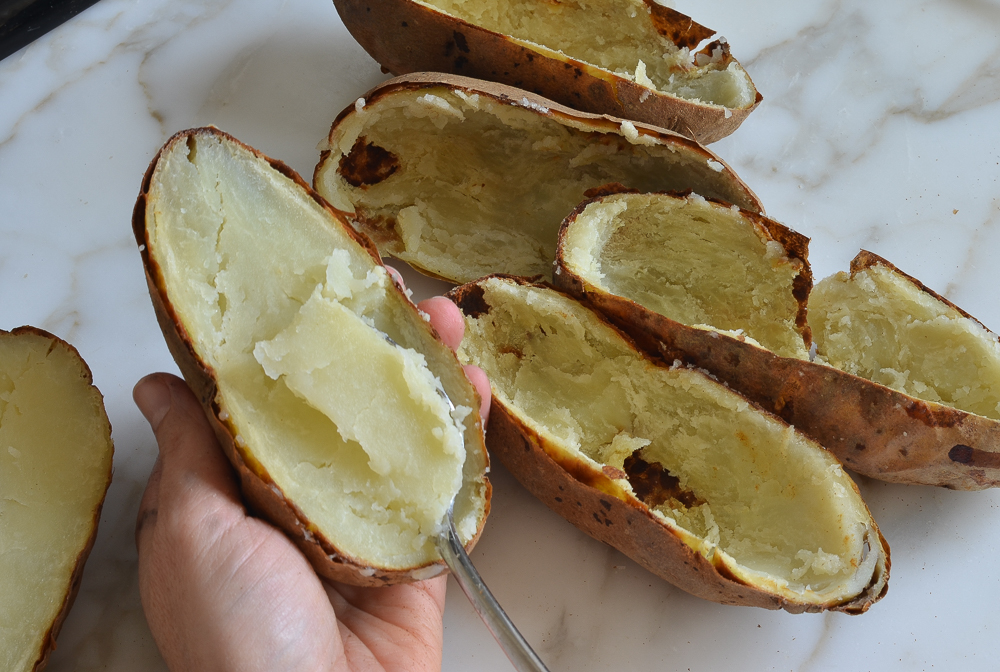
To begin, place the potatoes directly on an oven rack and bake until very soft, 50 to 60 minutes. While the potatoes are still hot, cut each in potato in half lengthwise. Scoop out all of the flesh from each potato half into the bowl of a stand mixer fitted with the paddle attachment (or the bowl of an electric mixer). Break the cooked potato flesh down into small pieces using a fork, potato masher, or rubber spatula.

Beat on low speed until completely smooth and no lumps remain, stopping the mixer to scrape down the sides and bottom of the bowl as needed. It’s important to do this while the potatoes are still hot, otherwise you’ll end up with lumps.

Meanwhile, in a small saucepan, bring the cream and butter to a simmer.
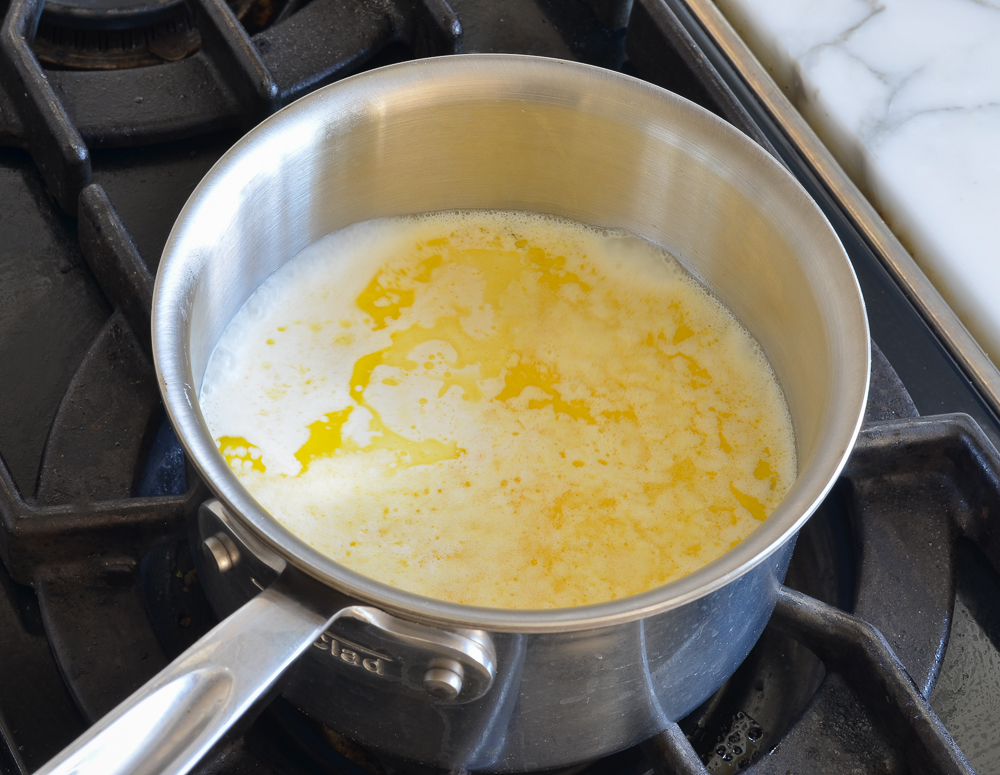
Remove the bowl from the mixer. Using a large rubber spatula, gradually fold in the hot cream and butter mixture. Folding (rather than stirring in the stand mixer) prevents the potatoes from becoming gluey.
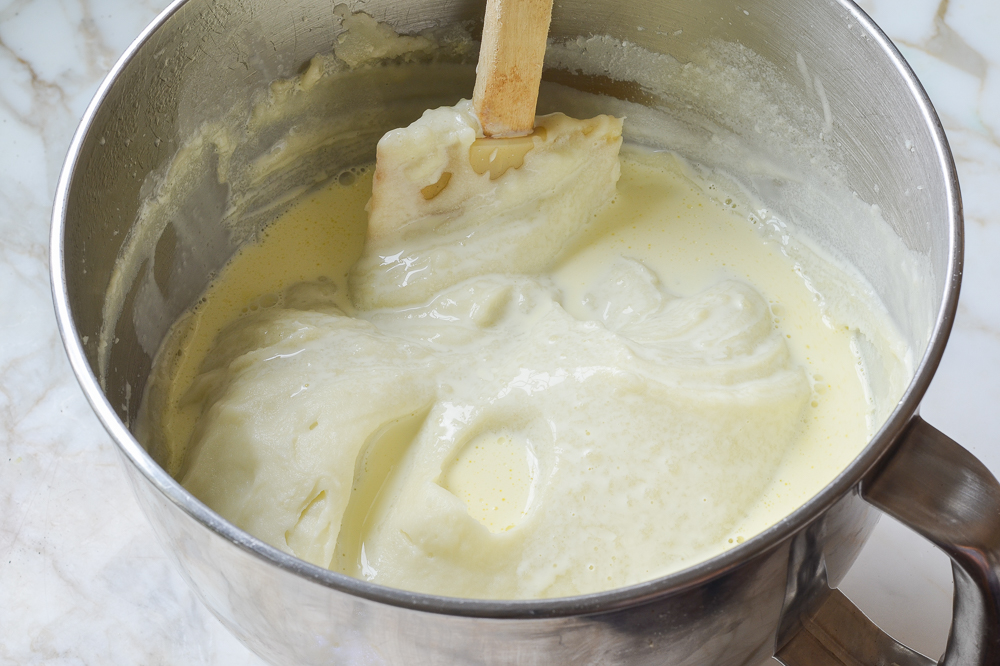
It will take a few minutes to mix the liquid in; keep folding until the potatoes are smooth and creamy. Mix in the salt, then taste and adjust seasoning, if necessary. Transfer the mashed potatoes to a large microwave-safe bowl and cover tightly with plastic wrap. Refrigerate for up to 2 days.
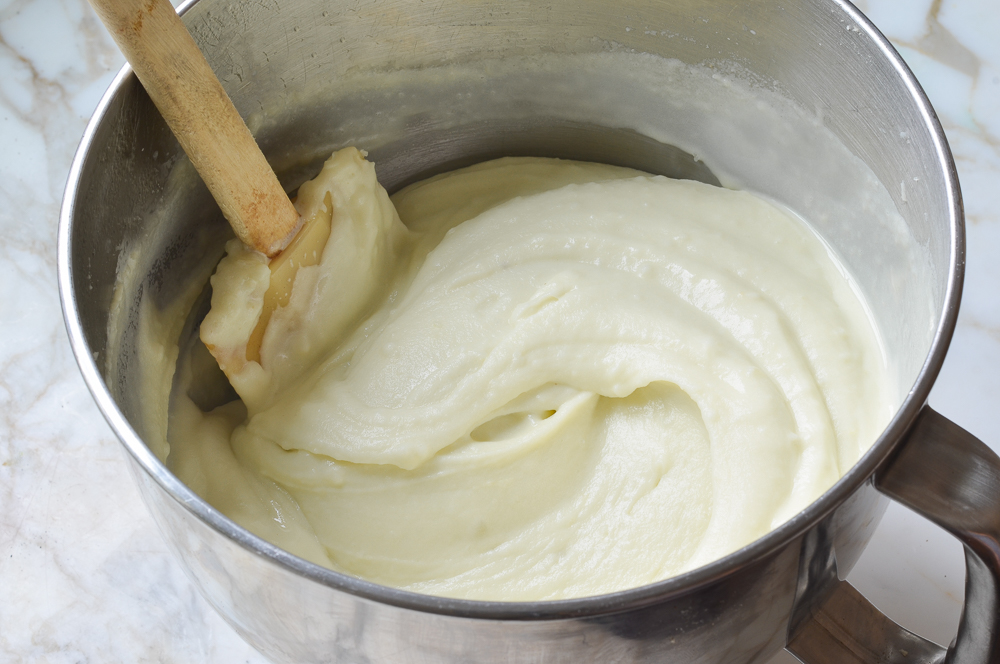
Reheating Instructions
To reheat, poke lots of holes in the plastic wrap with the tip of a knife and microwave at medium-high (75 percent) power for about 14 minutes. Stir the potatoes halfway through reheating to be sure they warm evenly. Season to taste, then transfer the potatoes to a serving bowl. Top with the remaining 2 tablespoons of butter and the chives and serve warm.
If you’d prefer to reheat the potatoes in the oven, transfer them to an oven-safe dish, cover tightly with foil, and bake in a 350°F oven for 30 to 40 minutes, stirring halfway through to ensure they heat evenly.
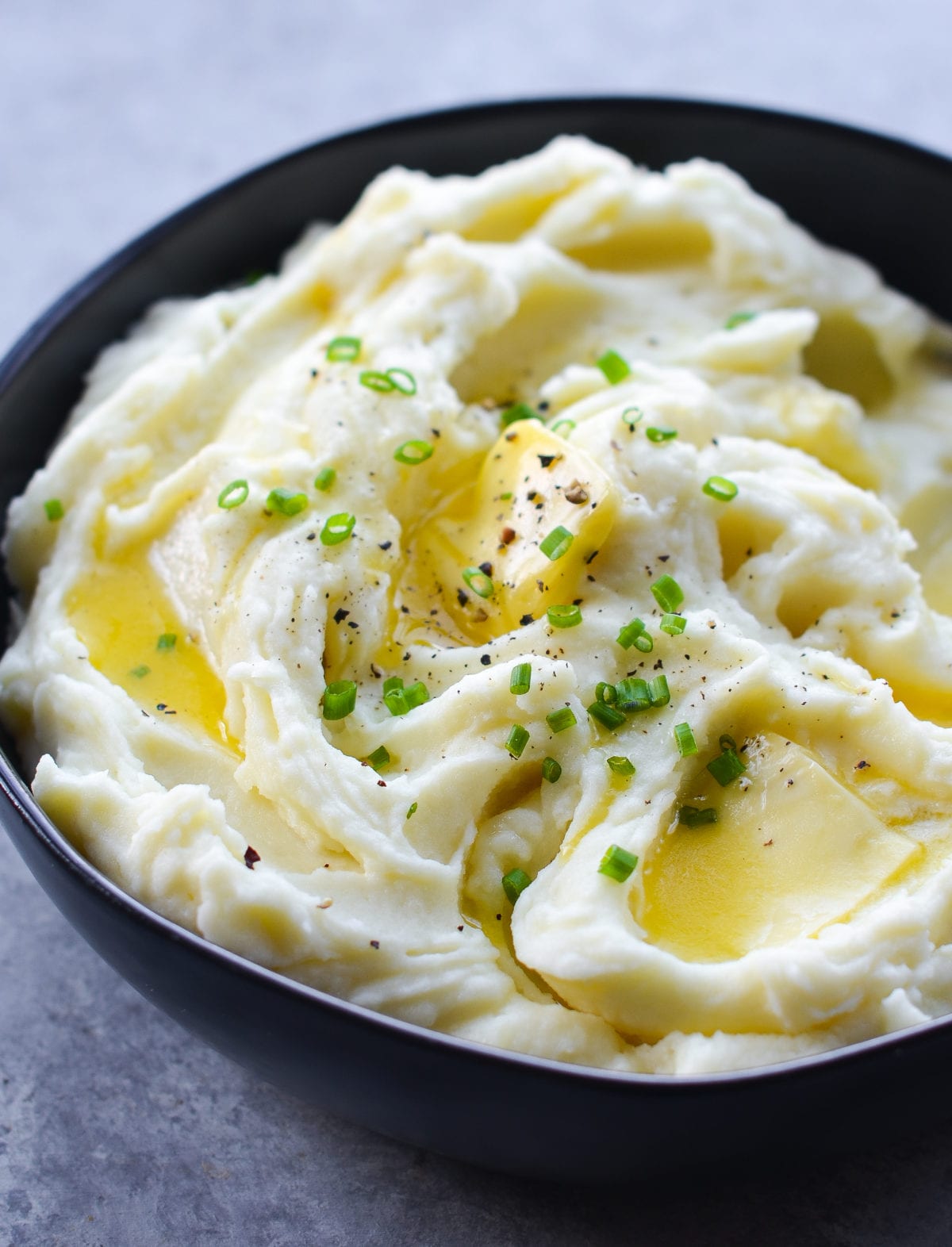
Video Tutorial
You May Also Like
Creamy Make-Ahead Mashed Potatoes
Perfect for the busy holidays, these ultra-creamy make-ahead mashed potatoes can be prepared two days ahead of time and reheated in the microwave.
Ingredients
- 3½ pounds Russet potatoes
- 2 cups heavy cream
- 8 tablespoons unsalted butter, divided
- 1½ teaspoons salt
- Chives, for serving
Instructions
- Preheat the oven to 450°F and adjust an oven rack to the middle position.
- Prick each potato a few times all over with a fork. Place the potatoes directly on the oven rack (alternatively, you can place them on a wire rack set in a rimmed baking sheet). Bake until very soft, 50 to 60 minutes, depending on the size of the potatoes. (Err on the side of overcooking rather than undercooking them.)
- Remove the potatoes from the oven. While they are still hot, cut each potato in half lengthwise. Using an oven mitt or a folded kitchen towel to hold the hot potatoes, scoop out all of the flesh from each potato half into the bowl of a stand mixer fitted with the paddle attachment (*see note below on using a potato ricer, food mill or hand-held electric mixer). The flesh near the skin gets a little tough, so be sure to leave it behind. Break the cooked potato flesh down into small pieces using a potato masher, fork, or rubber spatula. Beat on low speed until completely smooth and no lumps remain, 1 to 2 minutes, stopping the mixer to scrape down the sides and bottom of the bowl as needed. (Note: it’s important to mash the potatoes while they are still hot, otherwise you’ll end up with lumps.)
- Meanwhile, in a small saucepan over medium heat, bring the cream and 6 tablespoons of the butter to a simmer.
- Remove the bowl from the mixer stand and, using a large rubber spatula, gradually fold in the hot cream and butter mixture. It will take a few minutes to mix it all in; keep folding until the potatoes are smooth and creamy. Stir in the salt, then taste and adjust seasoning, if necessary. Transfer the mashed potatoes to a large microwave-safe bowl and cover tightly with plastic wrap (the bowl should be large enough that the potatoes don’t touch the plastic wrap). Refrigerate for up to 2 days. (DO NOT FREEZE)
- To reheat, use the tip of a knife to poke about 10 holes in the plastic wrap, and microwave at medium-high (75 percent) power until the potatoes are hot, about 14 minutes, stirring halfway through the reheating time. Taste and adjust seasoning, if necessary. Transfer the mashed potatoes to a serving dish, top with the remaining 2 tablespoons of butter, and sprinkle with the chives. Serve hot.
- Notes: For perfectly smooth potatoes, pass the potato flesh through a potato ricer or food mill before adding them to the mixer. If you don't have a stand mixer, you can use a hand-held electric mixer. If you don't have an electric mixer, pass the potatoes through a food mill or potato ricer and then whip by hand with a wooden spoon.
- Oven-Reheating Instructions: If you’d prefer to reheat the potatoes in the oven, transfer them to an oven-safe dish, cover tightly with foil, and bake in a 350°F oven for 30 to 40 minutes, stirring halfway through to ensure they heat evenly.
Nutrition Information
Powered by ![]()
- Per serving (8 servings)
- Calories: 464
- Fat: 34 g
- Saturated fat: 21 g
- Carbohydrates: 38 g
- Sugar: 3 g
- Fiber: 3 g
- Protein: 6 g
- Sodium: 470 mg
- Cholesterol: 112 mg
This website is written and produced for informational purposes only. I am not a certified nutritionist and the nutritional data on this site has not been evaluated or approved by a nutritionist or the Food and Drug Administration. Nutritional information is offered as a courtesy and should not be construed as a guarantee. The data is calculated through an online nutritional calculator, Edamam.com. Although I do my best to provide accurate nutritional information, these figures should be considered estimates only. Varying factors such as product types or brands purchased, natural fluctuations in fresh produce, and the way ingredients are processed change the effective nutritional information in any given recipe. Furthermore, different online calculators provide different results depending on their own nutrition fact sources and algorithms. To obtain the most accurate nutritional information in a given recipe, you should calculate the nutritional information with the actual ingredients used in your recipe, using your preferred nutrition calculator.

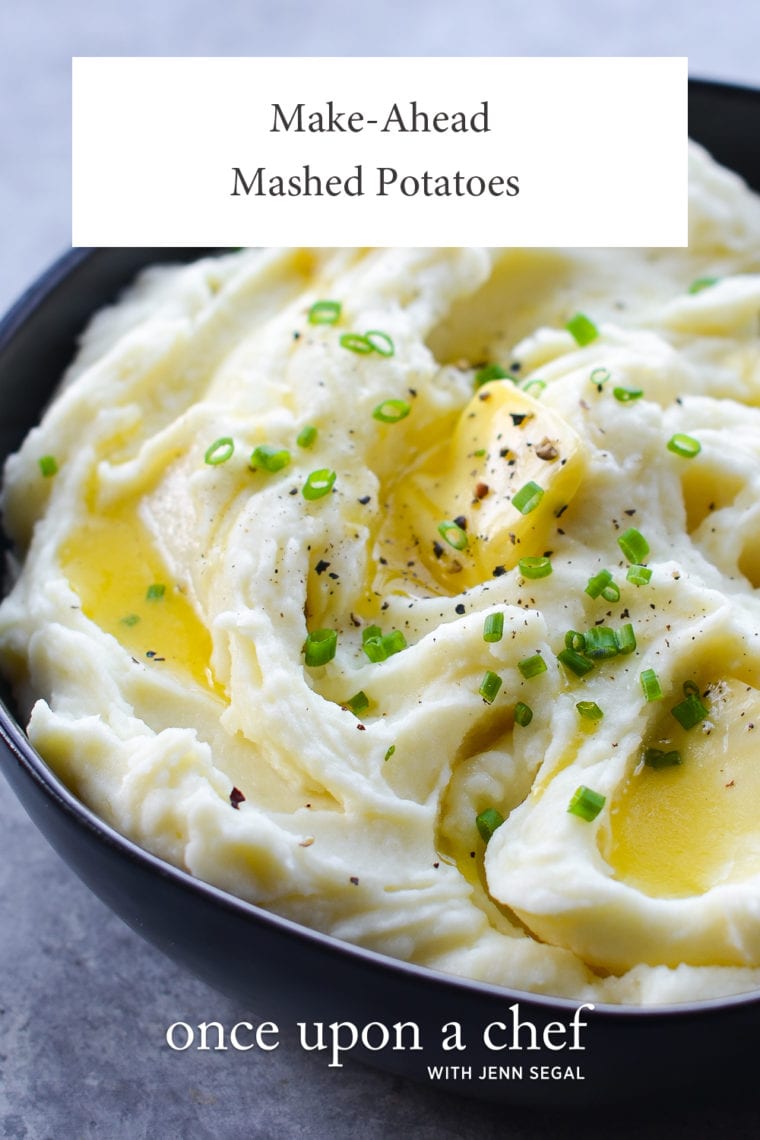
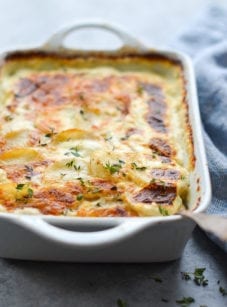
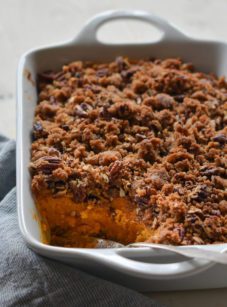
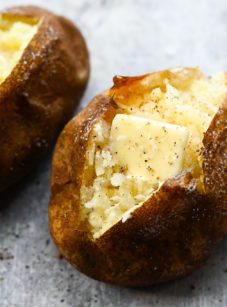
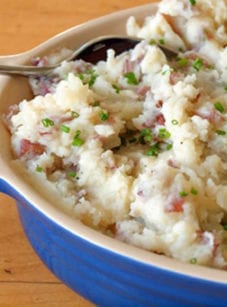
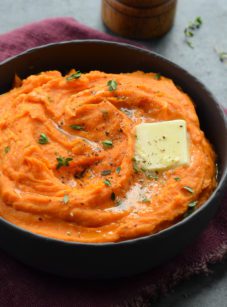
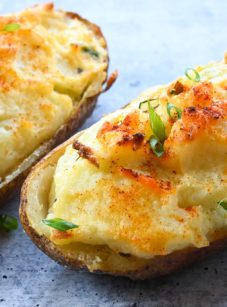
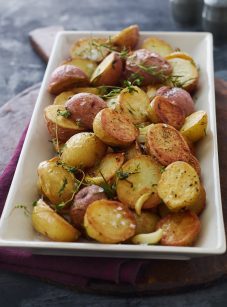
Can roasted garlic be added to these potatoes, or would it change the texture or the way they reheat? Thanks in advance!
Hi Karly, I think it would work nicely. Please let me know how it turns out!
Can I use whole milk instead of heavy cream??
I wouldn’t recommend it – sorry!
Hi! I made these last night and will need to add extra cream before serving. They’re more scoopable than creamy and able to stir. Any suggestions on the best way? I want to avoid them getting gummy. Thanks! On to your sausage stuffing now 🙂
Hi Janette, I’d warm them up halfway, fold in the additional cream (being careful not to overmix), then finish warming them.
Thanks!
I suggest wrapping in foil before you bake, i had a potato explode and now my freshly cleaned oven is a giant mess.
A helpful tip, if you pierce the potatoes they won’t explode. As the potato cooks, the steam builds up inside and the pressure is more than the skin can hold causing it to break open and explode. To prevent it in the future be sure to vigorously stab your potatoes multiple times with a knife or fork.
This is my go-to Thanksgiving day mashed potato recipe. Restaurant quality.
Can I use milk instead of heavy cream?
I wouldn’t recommend it — sorry!
Can I use salted butter?
Yes, while it varies by brand, most salted butter has approximately 1/4 tsp. salt per stick, so you can use the salted butter and reduce the salt in the recipe as needed. Hope that helps!
Can I use Eastern potatoes instead of Russet?
For the best results, I’d stick to Russets here — sorry!
Hi,
Can I use salted butter instead of unsalted and cut back on the salt added?
Yes, While it varies by brand, most salted butter has approximately 1/4 tsp. salt per stick, so you can use the salted butter and reduce the salt in the recipe as needed. Hope that helps and that you enjoy!
I would like to make these potatoes for Thanksgiving, but ny microwave can only be set at either 70% or 80%. Which do you suggest?
Hi Linda, I’d go with 70%. Hope you enjoy!
Do you know the amount of the ingredients to use if making the whole 5lb bag of potatoes?
I don’t and Math is not my strong suit but I think you’d need to increase other ingredients by about 1/3.
This is not anything I would ever make again. I have been making mashed potatoes for 60 years and these were an absolute embarrassment. Fortunately, I baked an entire 5 lb bag of potatoes and had some I could add at the end to try to improve the gooey, labor intensive, wasteful mess. Only redeeming thing was the leftover skins I can now fill with good newly made mashed potatoes and toppings. I suggest you modify your recipe to indicate the size of the potatoes you use, as well as the number of expected servings for average sized adults. People using a 5lb bag of smallish potatoes end up with about half the servings normally obtained when potatoes are peeled, and boiled before mashing.